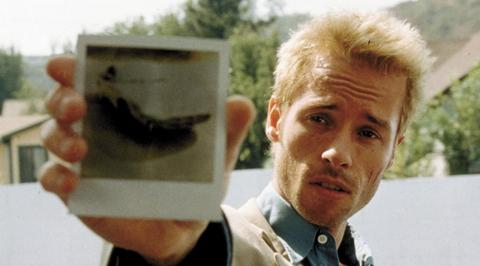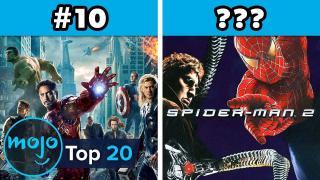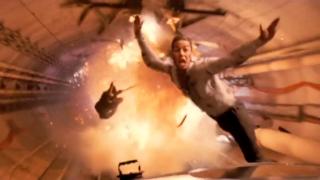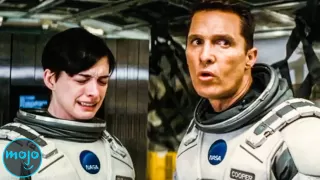Top 10 Non-Linear Narratives in Movies

Who says all movies need to follow a straight line? Join http://www.WatchMojo.com as we count down our picks for the Top 10 Non-Linear films. For this list, we're taking a look at films that effectively convey their stories out of chronological order, making the plot more compelling and thought provoking. However, we've excluded nonlinear films that use narrators as a framing device like “The Usual Suspects” and “The Social Network.”
Special thanks to our users PersonWhoIsntYourMot, halfwaytohell, Jonathan Freire, longjohnsilver, Sir Tubbington, antonius1903, mrepp@phasd.us and Mitten the Kitten for submitting the idea on our Suggestion Tool at http://www.WatchMojo.comsuggest
#10: “Once Upon a Time in America” (1984)
Top 20 Superhero Movies of ALL TIME
Almost thirty years after fleeing from Manhattan, gangster David ‘Noodles’ Aaronson returns to face his uncertain future and recollect his past. Noodle’s memories are triggered by a series of poignant visual cues, flawlessly transitioning from his boyhood street hustler days, to his rise up the rackets, and back to present day. As a testament to how crucial the nonlinear structure is here, this originally nearly four-hour epic was edited down and put into chronological order for its wide American release, robbing the narrative of its depth, sense of nostalgia, and poetry.
#9: “Rashomon” (1950)
Its non-linear narrative aside, this crowning achievement from Akira Kurosawa is also groundbreaking for its utilization of the Rashomon effect. The film recounts four contrasting versions of a murder, told from the perspectives of a bandit, a wife, a woodcutter who stumbled upon the scene of the crime, and even the deceased samurai who gives his testimony via a medium. By the film’s conclusion, the truth behind the murder isn’t what’s important. What truly matters is whether a priest’s faith in humanity can be restored after hearing such a disturbing tale.
#8: “I’m Not There” (2007)
Top 10 Movies Told Through Multiple Perspectives
Rather than making a straightforward biopic about the life of Bob Dylan, director Todd Haynes evaluates the musician from various standpoints in “I’m Not There.” The film follows several fictional characters inspired by the many lives of Dylan, most notably Cate Blanchett’s Oscar-nominated performance as a controversial folk singer that betrays his diehard fans. There’s no doubt that Dylan will always be remembered as a great songwriter and singer. Through this unique approach, however, we additionally see him as an outlaw, a poet, a prophet, and so much more.
#7: “Kill Bill: Volume 1” (2003)
Top 10 Action Movies with Surprisingly Low Kill Counts
Quentin Tarantino wasn’t the fist filmmaker to employ nonlinear storytelling, but he certainly helped popularize this narrative technique through movies like “Reservoir Dogs" and "Pulp Fiction." An even more ambitious example is in “Kill Bill,” which opens with a bang as a bride is shot in the head. From there, Tarantino begins to unravel a tale of betrayal and revenge full of colorful characters. Most of its chapters are told out of order, yet everything flows together perfectly as the bride’s past catches up with her present over the course of two volumes.
#6: “Eternal Sunshine of the Spotless Mind” (2004)
What makes the disjointed narrative in “Eternal Sunshine” so ingenious is how it completely catches the audience off guard in the final act. When Joel encounters Clementine on a train in the film’s beginning, we’re led to believe this is their first meeting. In the end, however, it’s revealed the two actually met at a beach party. Subsequently, they engaged in a relationship, broke up, and tried to expunge each other from their memories. Against all the odds, they meet again in Montauk, bringing this whole train ride full circle.
#5: “(500) Days of Summer” (2009)
Top 10 Space Movies That Are Scientifically Accurate
We all know how love stories go. Boy meets girl, boy loses girl, boy gets girl back. Since “(500) Days of Summer” isn’t a love story, though, it’s boy meets girl and boy loses girl, and not necessarily in that order. Jumping around 500 days, we see Tom’s complicated relationship with Summer at its best and worst. One day, he’ll be victoriously leading a parade. Another day, his parade’s literally rained upon. The 500th day might not end as Tom had hoped, but it does usher in a promising new autumn.
#4: “Annie Hall” (1977)
Before there was “(500) Days of Summer,” there was this nonlinear, not to mention unconventional, romantic comedy. Redefining Woody Allen’s directing career, “Annie Hall” opens with a neurotic Alvy Singer discussing his failed romance with the title character. He not only evaluates his relationship with Annie, but his relationships with family, schoolmates, and other past loves too. While the road is disjointed, it becomes clear the destination won’t be a storybook ending. That doesn’t mean our lovers can’t part on good terms, though, and fondly look back on old times.
#3: “Citizen Kane” (1941)
From its complex central character to its brilliant visual symbolism, “Citizen Kane” is often cited as the best film of all time for good reason. Orson Welles’ revolutionary use of nonlinear storytelling particularly cements the film’s masterpiece status, adding to the mystery as a reporter attempts to uncover the meaning behind Charles Foster Kane’s dying word. Through a series of interviews, we flashback to Kane’s rise and fall from greatness. Although the journalist pastes together a majority of Kane’s life, a vital piece remains missing when all’s said and done.
#2: “Memento” (2000)
The truth is that anybody can tell a story in reverse, but only a true creative genius could keep the audience guessing from start to finish. Christopher Nolan does exactly this in “Memento,” which follows a man suffering from anterograde amnesia as he tries to solve his wife’s puzzling murder. Ultimately, it’s revealed our protagonist’s life is a never-ending cycle spiraling counterclockwise. Through his Oscar-nominated screenplay, Nolan established himself as one of the most ambitious storytellers of this generation, which would carry on to future nonlinear mysteries like “The Prestige.” Before we wrap up this linear list with our top pick, here are a few honorable mentions: “Mulholland Drive” (2001) “Irréversible” (2002) “Sin City” (2005) “Run Lola Run” (1998) “Blue Valentine” (2010)
#1: “Pulp Fiction” (1994)
In what many consider his magnum opus, Quentin Tarantino strings together several interlocking stories about crime, redemption, and Royales with Cheese. Portraying these events out of order, “Pulp Fiction” is an unpredictable experience where even one of the main characters can die by the second act… which is technically the third act. The tone ranges from laidback to over-the-top, to philosophical, constantly leaving us wondering what the overall narrative’s working up to. As for the meaning behind this twisted anthology of sorts, that’s something you’ll want to keep analyzing with each repeated viewing. Do you agree with our list? What’s your favorite non-linear film? For more entertaining Top 10s published every day, be sure to subscribe to WatchMojo.com.




